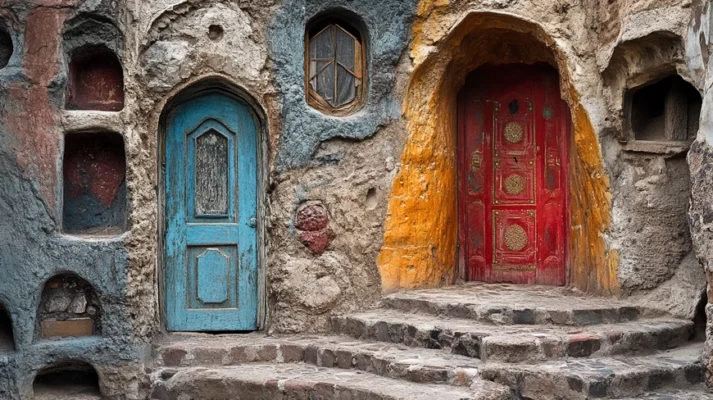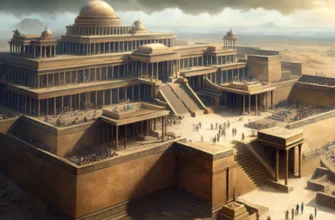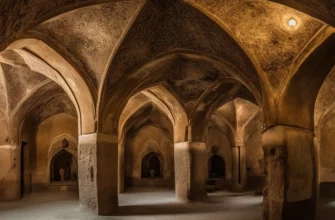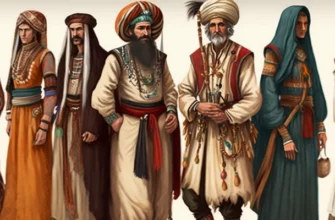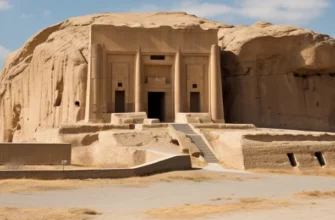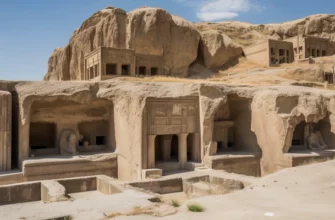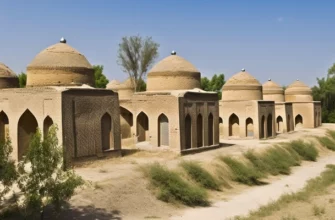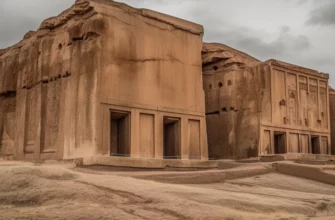Kandovan is one of the oldest and most interesting cities in Iran, located in the province of West Azerbaijan. Its main feature is its unique architecture, where buildings resembling mountain caves are carved directly into volcanic rock.
These natural “houses” have become part of the landscape and have been preserved since ancient times, making the city a true architectural wonder. The history of Kandovan dates back thousands of years. During the Sassanid Empire, the city was an important commercial and cultural center. Today, Kandovan is a popular tourist attraction, drawing visitors with its authenticity and historical atmosphere.
The locals have preserved their traditional way of life, which also adds to the town’s charm. Kandovan has become a symbol of ancient Iran, combining natural beauty and a rich cultural heritage.
Thanks to its unique architecture and cultural features, Kandovan remains an important place not only for Iranians but also for tourists from all over the world.
- History of Kandovan
- Early stages of the city’s development
- Important events in the history of Kandovan
- Archaeological finds and their significance
- The unique architecture of Kandovan
- Buildings in the rocks: techniques and materials
- Traditions and customs of the local people
- The role of Kandovan in Iranian culture
- Conclusions
History of Kandovan
Kandovan is a city with a centuries-old history deeply rooted in Iran’s cultural and architectural heritage. Its location in the mountains of Western Azerbaijan has made it a strategic point for various civilizations over the centuries.
The first mention of Kandovan dates back to the Sassanid era (224–651 AD). During this period, the city became an important trade and cultural center, actively interacting with other parts of Persia and neighboring states thanks to its geographical location.
Kandovan is distinguished by its unique architecture — buildings carved into volcanic rock. This specific construction technique allowed residents to create reliable shelters from natural disasters and protect themselves from possible attacks.
Over the centuries, the city has been repeatedly attacked and destroyed, but thanks to its natural fortress and exceptional architecture, Kandovan has survived. During the Islamic Revolution of 1979 and in the post-revolutionary period, the city underwent changes but retained its authenticity.
Today, Kandovan is not only a tourist center but also an important symbol of Iranian cultural heritage. Its history and architectural monuments continue to attract researchers, archaeologists, and tourists from all over the world.
Early stages of the city’s development
The history of Kandovan dates back to ancient times when the region was inhabited by people seeking protection from external enemies and natural disasters. The first archaeological activity in the territory of Kandovan indicates that the city began to develop in the pre-Islamic era, probably during the Sassanid period (224–651 AD). However, the city gained its greatest popularity thanks to its unique architecture, which arose from the need to adapt to the harsh conditions of the mountainous region.
The first settlements in the territory of Kandovan appeared near natural volcanic formations, where local residents carved caves in the rocks to shelter from the weather and possible attacks. This allowed them to create a complex and fairly effective defense system, which became the basis for the development of the town. Special construction techniques using natural materials such as stone, clay, and wood made it possible to create cozy and durable buildings that remain in excellent condition to this day.
In the first centuries of its existence, Kandovan was a small settlement that served mainly as a place of residence for rural families and craftsmen. Trade and connections with other cities in Iran were not yet very important, but thanks to its natural protection and favorable location, the town became an important place for local residents seeking safe shelter and a peaceful way of life in the mountainous region.
Important events in the history of Kandovan
Important events in the history of Kandovan
The Sassanid period (224–651 CE)
During this time, Kandovan became an important strategic point due to its location in a mountainous region, which allowed the city to be protected from enemies. The architectural features of the city, in particular the buildings in the rocks, began their history during this era, when local residents created shelters for themselves and their families. During the Sassanid Empire, the city became a commercial and cultural center that actively interacted with other parts of Persia.
Islamic conquest (7th century)
After the conquest of Iran by the Arabs in the mid-7th century, Kandovan became part of the Islamic world. This significantly changed the culture and religious traditions of the local inhabitants, but the architectural heritage remained unchanged. Kandovan, like many other mountain settlements, remained relatively isolated, which helped to preserve many ancient traditions and crafts.
Mongol raids (13th century)
During the Mongol conquests in the 13th century, Kandovan, like many other cities in Iran, was attacked. However, due to its natural defenses and unique architecture, the city was able to defend its independence and was not destroyed. This was an important moment in its history, as it ensured the preservation of its cultural heritage for future generations.
Ottoman-Safavid wars (15th–17th centuries)
During the Ottoman-Safavid conflicts, Kandovan remained an important regional center. Again, due to its mountainous location, the city remained outside the main front lines, which allowed it to maintain its stability and independence even during major political changes in the region.
The Islamic Revolution of 1979
After the Islamic Revolution, Kandovan became part of a broader movement to restore Iran’s cultural and religious identity. The city underwent changes, as did the rest of the country, but retained its traditional atmosphere. Its architecture and culture became an important part of the national heritage, attracting the attention of both tourists and researchers.
The development of tourism in the 21st century
In recent decades, Kandovan has become a popular tourist destination, attracting attention for its unique buildings carved into the rocks. This development began in the late 20th century and continues into the 21st century, with the city becoming popular among tourists, researchers, and photographers. Natural landscapes and historical monuments make Kandovan an important cultural center in Iran.
These events have shaped Kandovan’s image as a city with a rich history that has survived numerous trials but, thanks to its geography and cultural heritage, has been able to preserve itself and remain an important element of Iranian history.
Archaeological finds and their significance
Archaeological excavations in Kandovan have revealed many important facts about the ancient life of this city, its development, and its role in the region. The finds have helped not only to understand architectural traditions but also to study in greater depth the socio-economic processes that took place here over the centuries.
Architecture of buildings in the rocks
One of the most significant archaeological finds is the unique architecture of the city, in particular the buildings carved into volcanic rocks. These structures served as dwellings, workshops, and even temples, and are evidence of how local residents adapted their buildings to the challenging natural conditions. The artifacts found, such as stone tools and remains of building materials, allow researchers to understand how construction work was carried out and how many generations lived in these conditions.
Craft and household artifacts
Important finds include various household items such as pottery, stone tools, iron objects, and remnants of fabrics and tools. These artifacts provide valuable information about the daily life of local residents, their crafts, and their trade connections. In particular, some items indicate the existence of trade with other regions, confirming the importance of Kandovan as a commercial and cultural center.
Religious and cultural finds
Archaeological research has also uncovered religious artifacts, such as fragments of temples, cult objects, and seals, confirming the existence of religious rituals in Khandovan. The remains of shrines and cult buildings help to understand the religious practices of the city’s ancient inhabitants, as well as their relationship with natural forces and deities.
Burials and tombstones
One of the important archaeological finds were burials, which allowed researchers to study the funeral rites and social structure of the population of Khandovan. Analysis of the remains revealed a variety of funeral practices and pointed to social and cultural differences among the city’s inhabitants.
Discovery of ancient inscriptions
The inscriptions found on the walls of buildings and within the archaeological excavations have become an important source for studying the history of the city. They help to reconstruct the dates of important events and establish the names of rulers who influenced the development of Kandovan. These inscriptions are important for understanding the political situation in the region during different historical periods.
Overall, the archaeological finds in Kandovan are of great importance for the study of the history and culture of Iran. They allow us not only to understand the development of this particular city, but also to open new pages in the history of ancient Iran and its interaction with other cultures and civilizations.
The unique architecture of Kandovan
The architecture of Kandovan is one of the most unique in Iran and the world. The city is known for its buildings carved directly into volcanic rock, which creates a unique appearance and gives it an unusual charm. This architectural feature not only protected the inhabitants from natural disasters, but also became a symbol of the engineering genius of Iranian craftsmen.
Buildings in the rocks
The most distinctive feature of Kandovan is its buildings carved into the rock cliffs. This gives the city the appearance of “cave houses,” where the walls, roofs, and even the interior spaces are part of the natural rock. This architecture emerged as a response to the harsh mountain conditions and as a method of protection from external attacks. The technique of cutting into the rocks allowed for the creation of warm and stable dwellings that maintained a comfortable temperature throughout the year.
Construction techniques
The main feature of this architecture is the use of natural materials such as volcanic rock, which is known for its strength and thermal insulation properties. Not many external materials were used in construction, except for wood and clay for interior decoration. The buildings often have a dome-shaped roof, which helps to retain heat during the cold winter months and provides effective ventilation in summer.
Structure and layout
The houses in Kandovani are not separate buildings but part of a large network of structures carved into the rocks. Each house is connected to the others, forming a kind of labyrinth where dwellings often consist of several levels. This layout not only optimized the use of limited space, but also allowed residents to maintain a degree of privacy, even though they lived in such a densely populated environment.
Tourism and cultural aspects
Today, the architecture of Kandovana is not only an important element of cultural heritage, but also a major tourist attraction. The huge number of visitors who come here are fascinated by these natural buildings, which combine functionality, aesthetics, and historical value. The city has become a symbol of resilience and an innovative approach to architecture in harsh natural conditions.
Preservation and restoration
Given the age of the buildings, the preservation of architectural heritage is an important issue. The Iranian government and local authorities are actively working to preserve these unique buildings by developing restoration and reconstruction programs that maintain their condition while preserving the authenticity of the architecture.
The unique architecture of Kandovan is not only an architectural achievement but also a profound symbol of how human culture can adapt to nature, using its resources and maintaining harmony between nature and civilization.
Buildings in the rocks: techniques and materials
The buildings in Kandovana are a true architectural marvel, demonstrating the remarkable adaptation of humans to challenging mountain conditions. The town is famous for its “cave houses” carved into volcanic rock, which are the main architectural feature of this settlement. The construction techniques and materials used have made it possible to create reliable and efficient dwellings that keep warm in winter and cool in summer.
Construction techniques
The main construction technique used in Kandovan is that the buildings were carved out of natural volcanic rock. The locals used natural geological formations as the main framework for their dwellings. They carved their homes directly into the rocks, which saved on building materials and protected them from external enemies and natural disasters.
The buildings usually consist of several levels located one above the other. This layout allows for efficient use of limited space and also provides additional insulation from cold winds. Each level contains living quarters, while common areas for cooking and food storage are often located on the lower levels.
Building materials
The most important building material was natural stone, which had high thermal insulation and strength. The volcanic rocks that make up the cliffs retain heat well in winter and coolness in summer, which is an important characteristic for survival in such harsh conditions.
In addition to natural stone, clay and wood were used for construction. Clay was used for interior decoration and to seal cracks that appeared during rock cutting. It also helped to insulate buildings. Wood was used to make doors, window frames, and stairs, as well as to build interior partitions.
Architectural features
The buildings in Kandovan have a distinctive dome-shaped roof. This design reduces the amount of material used and increases the building’s resistance to natural disasters such as earthquakes, which are common in this region.
Thanks to this architecture, the rock buildings had excellent thermal insulation: they retained heat in winter and remained cool in summer. In addition, their specific shape and location in the rocks protected the inhabitants from strong winds and other natural disasters.
The role of architecture in protection and survival
Building in the rocks provides another important advantage: protection from enemies. The remarkable natural fortress that allowed the inhabitants of Kandovan to defend themselves from attacks became an important part of their way of life. Already in ancient times, this type of building and hiding place became a strategic solution for survival in conditions of political and military instability.
Modern preservation methods
Today, modern restoration methods are used to preserve these unique rock buildings, but the architectural principles used in their construction remain unchanged. The use of natural materials and the continuation of traditional techniques help to maintain a balance between preserving historical value and meeting modern requirements.
The buildings of Kandovan are not just dwellings, they are examples of architectural and engineering skill that has managed to adapt to the difficult conditions of the mountainous terrain. The technique of cutting into the rock and using natural materials demonstrates the local people’s deep understanding of their environment and their ability to create comfortable living conditions in a place where other construction methods would be ineffective.
Traditions and customs of the local people
Kandovan, with its unique architecture and centuries-old history, preserves many traditions and customs that are an integral part of the local culture. These traditions, which have developed in the harsh mountain environment, determine not only the way of life but also the social interactions and cultural identity of the inhabitants of this mountain settlement.
Traditional agriculture and crafts
For centuries, the local inhabitants of Kandovan have been engaged in agriculture, livestock breeding, and crafts, which have become the basis of their way of life. Due to the special natural conditions, gardening in Kandovan developed in limited space, and the main crops were vegetables and fruits that grow well in mountainous areas. They also kept domestic animals, especially sheep and goats, for dairy products and wool.
In addition, a significant part of the population were craftsmen who produced various items from clay, wood, and metal. Their work was an important part of everyday life and exports. Crafts such as blacksmithing, pottery, and woodworking are still preserved today.
Holidays and religious rituals
The locals of Kandovan, like most Iranians, follow Muslim traditions, which are reflected in religious holidays and rituals. One of the important holidays is Ramadan, the holy month of fasting, during which locals perform religious rituals, pray, and refrain from eating and drinking until sunset. After Ramadan, Eid al-Fitr is celebrated, accompanied by family gatherings, festive meals, and gifts.
Another important holiday is Eid al-Adha (Feast of Sacrifice), when families perform sacrificial rites and share meat with relatives, friends, and the poor.
Social customs and family traditions
In Kandovan, as in many other Iranian villages, the family plays an important role. Local residents usually live in large family groups, where several generations often live together under one roof. This organized way of life allows traditions, mutual assistance, and collectivism to be maintained.
The upbringing of children in Kandovan has its own characteristics, as children are involved in household chores and crafts from an early age, which are passed down from generation to generation. Girls learn needlework and housework, while boys learn to work on the land and raise livestock.
Culinary traditions
The cuisine of Kandovan also has its own characteristics, which are related to the mountain climate and available products. One of the main dishes is kasha (porridge made from wheat or barley), as well as various dishes made from milk, meat, and vegetables. Baked dishes are often prepared, including kebabs, which are popular at festive events and family gatherings.
Locals also make traditional dairy products such as yogurt, cheese, and kefir, which are an important part of their diet. Special attention is also paid to baked goods, which are often prepared in ovens carved into the rocks.
Music and dance
Kandovan also preserves traditions of folk music and dance. Music is often used during holidays and important events such as weddings and the birth of children. Local musicians use traditional instruments such as the darbuka (a Muslim drum) and the santur (a stringed instrument).
Dancing in Kandovan usually accompanies festive events and has its own specific movements that differ from dances in other regions of Iran. It is an important element of the cultural identity of the local people.
Customs of hospitality
As in many Iranian cities and villages, hospitality is one of the important features of Kandovan’s culture. Guests are always greeted with great attention and respect. Local residents often invite guests for tea or dinner and are ready to help each other in difficult situations.
The traditions and customs of Kandovan are an important part of the local identity, which is preserved and passed down from generation to generation. They are closely linked to the natural conditions of mountain life and religious beliefs, and demonstrate a deep sense of community and mutual respect among the inhabitants of this unique Iranian settlement.
The role of Kandovan in Iranian culture
Kandovan is not just a city, but an important part of Iran’s cultural heritage. Its unique architecture, traditions, and history make this settlement an important element of Iran’s national identity. Located in the mountainous regions of West Azerbaijan Province, the town is a testament to the deep cultural and social ties between people and nature, as well as reflecting the richness and diversity of Iranian civilization.
Architectural heritage
One of the most important components of Kandovan’s cultural value is its architecture. The buildings, carved into volcanic rock, are unique examples of the integration of human settlements with the natural environment. They not only demonstrate the practical knowledge and engineering skills of the local inhabitants, but also reflect the ancient traditions of Iranian construction. These buildings have become a symbol of endurance and the ability to adapt to the harsh conditions of the mountain environment.
Preserving the architectural heritage of Kandovan has become an important task for modern Iranians, as these structures not only have aesthetic and historical value but are also part of Iran’s shared cultural heritage, which is recognized as important for the development of national identity.
Place in tourism and cultural exchange
Kandovan is of great importance for Iranian tourism. Its architectural monuments, landscapes, and traditional way of life attract tourists from all over the world. The town has become a cultural center where visitors can not only see unique architecture but also learn more about the traditional way of life of Iranian mountain settlements. Tourism is an important factor for the local community’s economy and also contributes to the preservation of cultural heritage.
In addition, due to its uniqueness, Kandovan has become a site of cultural exchange. It attracts the attention of architects, historians, cultural experts, and tourists, which contributes to the promotion of Iranian culture on the international stage.
Preservation of cultural traditions
Kandovan is a place where traditional crafts and customs, which are an important part of Iranian culture, are preserved. Pottery, blacksmithing, and other traditional crafts are still actively practiced in Kandovan.
These crafts not only preserve the connection with the past, but also continue to shape the cultural atmosphere of the city.
Traditions of hospitality, religious rituals, and celebrations of important events are also an important part of the local culture. They reflect a deep sense of community and mutual respect, which is one of the core values of Iranian society.
Historical significance for Iran
Historically, Kandovan has played an important role in the development of Iran’s mountainous regions. The city became an important trading center and a place of strategic importance due to its geographical location. Kandovan has also witnessed many historical events and changes, which are reflected in the city’s archaeological finds and cultural features.
The city also serves as a symbol of resilience and adaptation, as its inhabitants have been able to survive and thrive in the mountainous terrain while developing their economic, artisanal, and cultural traditions.
Symbol of national identity
Kandovan is an important element of Iran’s national identity. Its unique architecture, traditions, way of life, and role in cultural exchange are part of the overall picture of Iranian civilization. The city demonstrates the connection between the past and the present and symbolizes the ability of Iranians to preserve their cultural values and adapt to new conditions.
Kandovan plays a key role in shaping the image of Iran as a country with a rich history and deep cultural traditions that are preserved and passed down through generations.
Kandovan occupies an important place in Iranian culture thanks to its unique architecture, traditions, and history. This city is a symbol of the richness of Iran’s heritage, which is preserved and passed down through generations. Its role in tourism, the preservation of traditions, and cultural exchange makes it important not only for local residents but also for the entire Iranian nation.
Conclusions
Kandovan is an important part of Iran’s cultural and historical heritage, and its significance for the country cannot be overstated. Its unique architecture, traditions, and history make this city an important element of national identity. However, several aspects need to be considered to ensure its preservation and development in the future.
One of the main challenges for Kandovan’s future is the preservation of its architectural heritage. The buildings carved into the rocks are subject to natural factors such as weathering and earthquakes over time. It is therefore necessary to work continuously on the restoration and maintenance of these structures in order to preserve their uniqueness for future generations. In addition, it is important to use modern technologies to preserve the structure of the buildings without compromising their authenticity.
The growing interest in Kandoan among tourists has great potential for the economic development of the city. Tourism can become a major source of income for local residents, creating new jobs in the hotel business, crafts, and guiding.
However, for tourism development to be sustainable, it is important to control the impact of tourists on the natural environment and preserve cultural traditions. Kandovan is also an important center for the preservation of local crafts. Traditional activities such as blacksmithing, pottery, and woodworking are an important part of the city’s cultural heritage. The development of these industries and the transfer of knowledge to new generations can be an important economic factor in preserving local culture. Despite current challenges, including climate change and urbanization, Kandovan has great potential for development if the right strategies are implemented.
To support sustainable development, it is important to improve infrastructure without disturbing the ecological balance and to preserve the natural environment.
Kandovan is of great importance to Iran not only as part of its national cultural heritage, but also as a symbol of humanity’s ability to adapt to challenging natural conditions. This city is an important element of Iran’s cultural identity, attracting attention on the international stage. In the future, Kandovan could become an important center for the study of traditional architecture and culture, and its preservation will be of great importance for Iran’s national identity.
